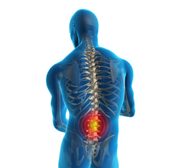Failed Back Surgery
Failed back surgery syndrome (also called FBSS, or failed back syndrome) is a misnomer, as it is not actually a syndrome – it is a very generalized term that is often used to describe the condition of patients who have not had a successful result with back surgery or spine surgery and have experienced continued pain after surgery. There is no equivalent term for failed back surgery syndrome in any other type of surgery (e.g. there is no failed cardiac surgery syndrome, failed knee surgery syndrome, etc.).
Failed back surgery syndrome (FBSS) is seen in 10-40 percent of patients who undergo back surgery. It is characterized by intractable pain and varying degrees of functional incapacitation occurring after spine surgery. There are many reasons that a back surgery may or may not work, and even with the best surgeon and for the best indications, spine surgery is no more than 95% predictive of a successful result.
Reasons for Failed Back Surgery and Pain after Surgery
Spine surgery is basically able to accomplish only two things:
- Surgically decompress a nerve root that is pinched, or
- Stabilize a painful joint
Unfortunately, back surgery or spine surgery cannot literally cut out a patient’s pain. It is only able to change anatomy, and an anatomical lesion (injury) that is a probable cause of back pain must be identified prior to rather than after back surgery or spine surgery.
By far, the number one reason some patients experience continued pain after surgery, is because the lesion that was operated on is not in fact the cause of the patient’s pain.
Predictability of Pain after Surgery
Some types of back surgery are far more predictable in terms of alleviating a patient’s symptoms than others. For instance,
- A discectomy (or microdiscectomy) for a lumbar disc herniation that is causing eg pain is a very predictable operation. However, a discectomy for a lumbar disc herniation that is causing lower back pain is far less likely to be successful.
- A spine fusion for spinal instability (e.g. spondylolisthesis) is a relatively predictable operation. However, a fusion surgery for multi-level lumbar degenerative disc disease is far less likely to be successful in reducing a patient’s pain after surgery.
Therefore, the best way to avoid a spine surgery that leads to an unsuccessful result is to stick to operations that have a high degree of success. And, to make sure that an anatomic lesion that is amenable to surgical correction is identified preoperatively.
Other Causes of FBSS and Continued Pain after Surgery
In addition to the above-mentioned cause of failed back surgery syndrome, there are several other potential causes of a failed surgery, or continued pain after surgery:
- Fusion surgery considerations (such as failure to fuse and/or implant failure, or a transfer lesion to another level after a spine fusion, when the next level degenerates and becomes a pain generator).
- Lumbar decompression back surgery considerations (such as recurrent spinal stenosis or disc herniation, inadequate surgical decompression of a nerve root, preoperative nerve damage that does not heal after a decompressive surgery, or nerve damage that occurs during the surgery).
- Scar tissue considerations (such as epidural fibrosis, which refers to a formation of scar tissue around the nerve root). Post-operative rehabilitation (continued pain from a secondary pain generator).
Scar Tissue and Continued Pain After Back Surgery
Scar tissue formation is part of the normal healing process after back surgery. While scar tissue can be a cause of pain, actual scar tissue pain is very rare since the tissue contains no nerve endings. Rather, the principal mechanism of pain is thought to be the binding of the lumbar nerve root by fibrous adhesions, called epidural fibrosis. Postoperative stretching exercises can help decrease the effects of postoperative scarring around the nerve root.
Scar Tissue Formation after Back Surgery
All patients will heal with scar tissue after undergoing back surgery, as this is the only way to heal. The reality is that although scar tissue is often clinically the reason given for continued pain after surgery, it is probably rarely the cause of postoperative pain. Particularly in patients that have similar pain postoperatively to what they had before surgery, it is unlikely that the addition of scar tissue has an clinical relevance.
However, clinicians often use the explanation of scar tissue as the cause of continued pain, whether or not there is any evidence that this is in fact the patient’s pain generator. Often, a better explanation for continued pain after surgery is that either the patient has a secondary problem that needs to be addressed, or that the lesion operated on was not in fact the source of the patient’s pain. These are far more likely scenarios than actual scar tissue pain.
A Possible Exception for Scar Tissue Pain
The one time that scar tissue (epidural fibrosis) may be symptomatic is for a patient who initially does well after a lumbar discectomy or a surgical decompression, only to have recurrent pain come on slowly between 6 to 12 weeks after surgery. This is the time period that scar tissue takes to form, and as it forms it can cause the nerve root to become adherent within the spinal canal. Keeping the nerve moving through stretching exercises can help prevent this scenario. Pain that starts years after surgery, or pain that continues after surgery and is never relieved, is not from scar tissue.
Suffering From Failed Back Surgery ?
We Can Help!
Call Us Today (021) 436 – 0009



